Scientific papers 2024



Authors: Marc Roig, & Jacopo Cristini
Dopamine, a key neurotransmitter, is crucial for managing
mood, motivation, learning, and other functions. Changes
in dopamine levels are linked to cognitive decline and
various mental and neurological disorders, including the
cardiorespiratory system. Research, including animal
studies, shows that regular cardiovascular exercise, like
treadmill running, can boost dopamine levels in the brain,
potentially offsetting some of these issues.

Authors: Edward Tom Ashworth, Ryotaro Ogawa, David
Robert Vera, Peter Lindholm
Using a radioactive nitrogen isotope, this study found that
pre-breathing oxygen at normobaric levels increased
nitrogen levels in the blood, liver, and muscle. However,
hyperbaric exposure showed no differences in tissue
nitrogen levels. Both bone and muscle had higher
nitrogen levels after hyperbaric exposure than normobaric
exposure. The study concludes that pre-breathing oxygen
eliminates nitrogen at normobaric levels, and tissues are
slower to adjust their nitrogen levels under hyperbaric
conditions.




Authors: Antonis Elia, Matthew J. Barlow, Matthew J. Lees,
Georgios Petri, Michail E. Keramidas
This study investigated the physiological effects of
repeated maximal static and dynamic apnea on stress-
related biomarkers in eleven healthy men. The results
showed significant increases in modified albumin and
myoglobin levels after the apnea interventions, particularly
after dynamic apnea, indicating muscle damage.
However, there were no significant changes in neuron-
specific enolase or cardiac troponin, suggesting no
myocardial or neuronal damage. The study concludes that
dynamic apnea causes more muscle damage than static
apnea, but neither causes heart or brain damage.


Authors: Warren Burggren, Andreas Fahlman, William
Milsom
Many animals exhibit irregular breathing patterns with
long pauses between breaths, even when their hearts are
beating. This phenomenon is common among all species,
from crustaceans to whales. In humans, this irregular
breathing pattern is associated with health issues.Diving
animals exhibit cardiovascular phenomena that lack
standardized terminology, leading to confusion regarding
the underlying mechanisms and pathologies. To avoid
confusion and emphasize understanding of biological
processes rather than terminology, more precise terms are
proposed.



Authors: Costantino Balestra, Sara Baldelli, Fabio Virgili,
Michele Salvagno, Simona Mrakic-Sposta, &
Deborah Fratantonio
The "normobaric oxygen paradox" (NOP) refers to the
perceived lack of oxygen by tissues following a hyperoxic
event. The authors investigate whether this phenomenon
results in the production of advanced glycation end
products (proteins or lipids glycated by exposure to
sugars) and advanced oxidation protein products
(modified proteins resulting from oxidative stress) as
circulating biomarkers of oxidative stress.
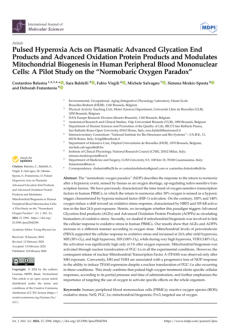

Authors: Taylor Diederich, Allyson M. Briggs, Adrienne
Malik, Bryan Beaver
This article discusses the case of a 32-year-old individual
who developed a mottled rash, joint pain, muscle aches,
headaches, vision changes, and weakness due to
decompression sickness resulting from working in a
pressurized chamber at a factory. The individual
underwent two sessions in a hyperbaric chamber, which
completely resolved the symptoms. During the hospital
stay, a patent foramen ovale was discovered. The patient
was advised to avoid any further exposure to similar work
environments.


Authors: Elsye Fitriasari, Ni Komang Sri Dewi Untari,
Nasywa Annisa Fitra
Decompression sickness (DCS) is a serious health problem
for divers caused by pressure changes during and after
dives. It is important for all medical professionals and divers
to understand the risks associated with DCS in order to
promote safe diving practices. Symptoms of DCS can be
rapid or gradual and may be delayed, making diagnosis
difficult, especially if the diver has traveled by air after
diving. Factors such as obesity, smoking, alcohol
consumption, anxiety, previous injuries, and diving
conditions, including cold water, duration, and depth,
increase the risk of DCS.


Authors: Muhamad Nanang Solikhin, Sumaryanti,
Sulistiyono, Fauzi, Bonifacius Arbanto
This review covers studies on breath-holding exercises and
their health benefits, including their impact on freedive
training, lung function through diaphragmatic breathing,
and breath-hold performance with mental imagery
training. Research also shows improvements in
cardiorespiratory function for individuals with bronchial
asthma, chronic obstructive pulmonary disease, and
cancer, noting better pulse rates, blood pressure,
respiratory function, and quality of life.


Authors: Jean-Pierre Imbert, Lyubisa Matity, Jean-Yves
Massimelli, Philip Bryson
This is a review of commercial heliox saturation
decompression procedures. The scope does not include
compression, storage depth or bell excursion dive
procedures. The objectives are to: identify the sources of
the procedures; trace their evolution; describe the current
practice; and detect relevant trends.
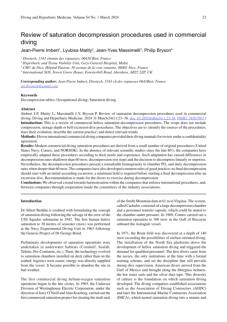

Authors:
Felix R. M. Beinlich , Antonios Asiminas, Verena Untiet,
Zuzanna Bojarowska, Virginia Plá, Björn Sigurdsson,
Vincenzo Timmel, Lukas Gehrig, ichael H. Graber, Hajime
Hirase, Maiken Nedergaard
Consciousness disappears within seconds after blood flow
to the brain stops because the brain cannot store oxygen
and requires a continuous supply to function. The
researchers developed a new tool to monitor oxygen
levels in the brain. Using this tool, they discovered
spontaneous low-oxygen areas in the brains of awake
mice. This research sheds light on how the brain manages
oxygen and could help understand various brain
conditions and diseases.


Authors: Alessandra Vezzoli, Simona Mrakic-Sposta,
Andrea Brizzolari, Costantino Balestra, Enrico
Maria Camporesi, and Gerardo Bosco
Underwater activities expose divers to conditions that can
lead to oxidative stress and inflammation caused by an
imbalance between reactive oxygen/nitrogen species and
antioxidants. These conditions are influenced by factors
such as hypoxic and hyperoxic environments, hyperbaric
pressure, cold water, and different breathing gases. Divers
experience physiological adaptations known as the "dive
response,", which includes cardiovascular stress, increased
blood pressure, peripheral vasoconstriction, altered blood
gas levels, and the risk of bubble formation during
decompression.
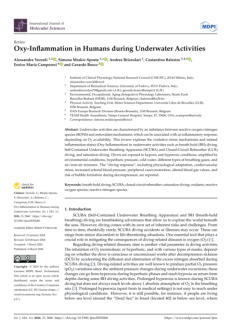

Authors:
Sotiris P. Evgenidis, Konstantinos Zacharias, Virginie
Papadopoulou, Sigrid Theunissen, Costantino Balestra,
Thodoris D. Karapantsios
Impedance spectroscopy technology (I-VED),was used for
the first time in humans to provide qualitative in vivo
electrical impedance measurements that may contribute
to the assessment of decompression stress. Compared to
ultrasound imaging, the proposed method is less
expensive, operator-independent, and compatible with
continuous monitoring and the use of multiple probes.
This study presents preliminary findings. Further calibration
and validation are necessary to determine the sensitivity
and specificity of I-VED.


Authors: José A. Bragada, Pedro M. Magalhães, Eric São-
Pedro, Raul F. Bartolomeu, and Jorge E. Morais
The study aimed to evaluate the accuracy of predicting
oxygen consumption (O2) during aerobic activities using
net heart rate (netHR), sex, and BMI in active adults. NetHR
is calculated by subtracting the resting heart rate from the
average heart rate during the activity. The study involved
156 participants, aged 18 to 81, including 52 women and
104 men, who had their netHR and net oxygen intake
(netVO2) measured.


Authors:
Nikolaus C. Netzer, Heidelinde Jaekel, Roland Popp,
Johanna M. Gostner, Michael Decker, Frederik Eisendle,
Rachel Turner, Petra Netzer, Carsten Patzelt, Christian
Steurer, Marco Cavalli, Florian Forstner, and Stephan
Pramsohler on behalf of the Hypoxiflight Study Group
This study aimed to investigate whether flight conditions in
a hypobaric chamber, simulating altitudes of 2500 m and
4500 m with varying oxygen levels, could induce oxidative
stress in healthy individuals. Twelve vaccinated participants
underwent a 3-hour simulation with oxygen levels
adjusted between 35% and 100%. Their arterial blood
pressure and oxygen saturation were monitored, and
blood samples were analyzed for oxidative stress markers
at different stages of the experiment.


Authors: Maya V. Voronina, Anastasia S. Frolova, Ekaterina
P. Kolesova, Nikita A. Kuldyushev, Alessandro
Parodi, and Andrey A. Zamyatnin
Cell survival depends on a balance between the
accumulation of damage and repair mechanisms.
Oxidants, now recognized as physiological molecules, can
damage vital cell components and lead to cell death. Cells
counteract this with processes such as autophagy, which
recycles damaged parts with the help of lysosomes and
enzymes such as cathepsins. These elements help
determine whether a cell undergoes apoptosis or
autophagy. This review examines the role of ROS and
cathepsins in cell death and autophagy, emphasizing their
interrelated dynamics.


Authors: Lidia Maeso, Pablo Edmundo Antezana, Ailen
Gala Hvozda Arana, Pablo Andrés Evelson, Gorka
Orive, and Martín Federico Desimone
Skin is important for protection and healing. Chronic
wounds are a worldwide problem caused by oxidative
stress that damages cells and delays healing. Proper care
and antioxidants can help manage chronic wounds.
Natural polymers with antioxidants can create
regenerative environments for skin wound healing.



Click on the octopus
to return to the top
of the page


Authors: Harry B. Rossiter, David C. Poole
This text acknowledges and corrects a previous mistake in
a scholarly work, clarify the correct references, and
engage in a professional discussion about the specifics of
breath-by-breath gas exchange measurement algorithms.
The authors thank Drs. Francescato and Cettolo for their
input, correct the misattribution of an algorithm to
Grønlund (1984) instead of the intended IND algorithm,
and clarify the context of their references. Additionally,
they discuss the technical details of the algorithms and
seek agreement on a specific point related to the
occurrence of expiration between consecutive
inspirations.


Authors: Dominik André-Lévigne, Rodrigue Pignel, Sylvain
Boet, Vincent Jaquet, Daniel F. Kalbermatten, &
Srinivas Madduri
This study intends to review and discuss the various roles
of oxygen in peripheral nerve regeneration, with a
particular focus on the potential therapeutic benefits of
hyperbaric oxygen therapy. It highlights the influence of
different oxygenation states on nerve repair and
regeneration, summarizes current knowledge and data on
the effectiveness of hyperbaric oxygen therapy for treating
nerve injuries, and suggests future research directions in
this area.
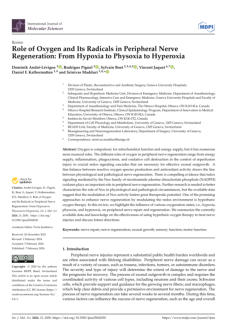

Authors: Anna Taboni, Nazzareno Fagoni, Timothée
Fontolliet, Giovanni Vinetti, Guido Ferretti
This study investigated the physiological responses during
a transition from rest to exercise under hypoxic (H) and
normoxic (N) conditions. Specifically, the study aimed to
test two hypotheses: (i) that the initial decrease in
baroreflex sensitivity (BRS) would be slower in hypoxia
compared to normoxia, and (ii) that the fast heart rate (HR)
and cardiac output (CO) responses would have smaller
amplitudes in hypoxia due to lower vagal activity. The text
details the study's methods, results, and conclusions,
highlighting the differences in physiological responses
between the two conditions.
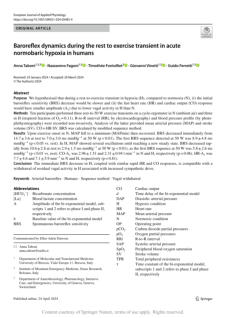

Authors: Marina Vulic, Branislav Milovanovic, Ante Obad,
Duška Glavaš, Igor Glavicic, Damir Zubac, Maja
Valic, & Zoran Valic
This study investigated the effects of SCUBA diving at
different depths (10 m and 20 m) on heart rate variability
(HRV) parameters in healthy individuals to determine if
cardiac sympathetic activity adapts proportionally to diving
depth and if HRV parameters can track changes in cardiac
autonomic nervous system (ANS) function during and
after diving. The results indicate that SCUBA diving affects
the cardiac ANS, with specific HRV parameters showing
significant changes during dives and returning to baseline
after ascent. The authors suggest that these HRV markers
could be used to monitor cardiovascular risks and
potential benefits associated with underwater activities.
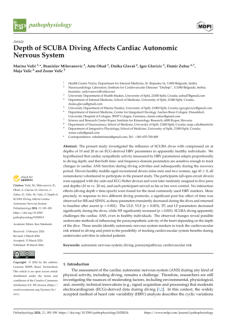

Authors: Benjamin L Turner, Pieter-Jan AM van Ooij, Thijs T
Wingelaar, Rob A van Hulst, Edwin L Endert, Paul
Clarijs, Rigo Hoencamp
This document discusses a study that applied a 'chain of
events analysis' (CEA) framework to understand the causes
of diving injuries treated by the Diving Medical Centre of
the Royal Netherlands Navy to identify the factors leading
to these injuries, including predisposing factors, triggers,
disabling agents, and disabling conditions, and to evaluate
the effectiveness of the CEA framework in analyzing diving
injuries.


Author: Simon J Mitchell
This document provides a comprehensive overview of
decompression illness, specifically focusing on the
pathophysiology, manifestations, prevention, and
treatment of decompression sickness (DCS) and arterial
gas embolism (AGE). It aims to educate readers about the
causes, mechanisms, and potential health impacts of these
conditions, as well as to inform them about how to
prevent and manage these diving-related disorders.


Authors: Md-Billal Hossain, Kia Golzari, Youngsun Kong,
Bruce J. Derrick, Richard E. Moon, Michael J.
Natoli, M. Claire Ellis, Christopher Winstead-
Derlega, Sara I. Gonzalez, Christopher M. Allen,
Mathew S. Makowski, Brian M. Keuski, John J.
Freiberger, Hugo F. Posada-Quintero, Ki H. Chon
This study aimed to predict central nervous system oxygen
toxicity (CNS-OT) in SCUBA divers by analyzing
electrodermal activity (EDA) using machine learning
techniques. It focused on the dynamics of EDA while
subjects are exposed to elevated oxygen partial pressures
in a hyperbaric environment. The goal was to develop a
predictive model to identify the onset of CNS-OT
symptoms early enough to allow for countermeasures,
thereby improving diver safety.


Authors:
Boxiong Guo, Yixuan Sun, Yuehua Wang, Ya Zhang, Yu
Zheng, Shixia Xu, Guang Yang, & Wenhua Ren
This study investigates the evolutionary adaptations in the
respiratory systems of cetaceans and other marine
mammals. It focuses on the genetic basis of these
adaptations, particularly in relation to pulmonary fibrosis
and diving behavior. It highlights the identification of
specific genes that have undergone accelerated evolution
and positive selection and how these genetic changes
contribute to lung morphology that reduces the risk of
decompression sickness (DCS) during diving. The research
also aims to provide insights relevant to understanding
human diving physiology.
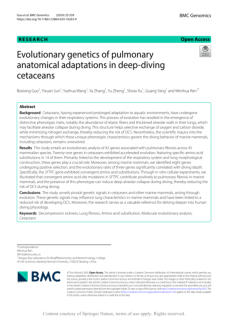

Authors: Costantino Balestra, Clément Lévêque, Simona
Mrakic-Sposta, Alessandra Vezzoli, Pierre Wauthy,
Peter Germonpré, Frauke Tillmans, François
Guerrero, & Pierre Lafère.
This study discusses the relationship between diving
decompression and inflammatory processes. It aims to test
the hypothesis that inflammatory processes can generate
micronuclei, which may increase the risks associated with
diving. It outlines the methodology, including using
echocardiography to count venous gas emboli (VGE) and
collecting saliva and urine samples to measure various
markers of inflammation. The results indicate a correlation
between inflammation and the presence of VGE,
suggesting that inflammation may play a role in the
formation of micronuclei during diving.
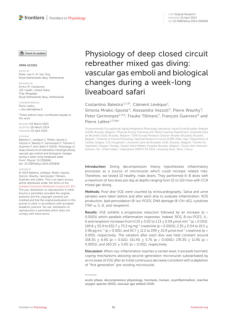

Authors:
Jean-Pierre Imbert, Axel Barbaud, Sian Stevens, Craig Miller,
Hilary Peace, Helene Rossin, Alain Letourneur, Phil Bryson,
Bo Damsgaard, Costantino Balestra
This study on saturation diving stressors and the
effectiveness of different saturation procedures was
conducted in the North Sea Danish sector and aimed to
document the level of diving stress and compare the
Boskalis and NORSOK procedures. The results indicated
minimal stress and no significant differences between the
two procedures at depths of 40-50 msw. The authors
suggest further research for deeper dives where more
significant stress is anticipated.


Authors: Feiko J. M. de Jong, Thijs A. Lilien, Dominic W.
Fenn, Thijs T. Wingelaar , Pieter-Jan A. M. van
Ooij, Anke H. Maitland-van der Zee, Markus W.
Hollmann, Rob A. van Hulst, & Paul Brinkman
This paper describes a pilot study to identify volatile
organic compounds (VOCs) associated with pulmonary
oxygen toxicity (POT) using an in vitro model of alveolar
basal epithelial cells exposed to hyperbaric and hyperoxic
conditions. It also evaluates the feasibility of using this in
vitro model for POT biomarker research and details the
experimental protocol, the analysis of VOCs using gas
chromatography-mass spectrometry, and the findings,
which include significant variations in certain VOCs and
increased cellular stress markers in the intervention group.
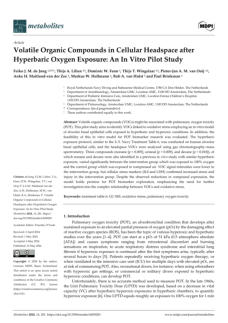

Authors: Janne Bouten, Louise Declercq, Jan Boone,
Franck Brocherie, Jan G. Bourgois
This document evaluates the potential of apnoea as a
training method to enhance aerobic performance and
discusses the effectiveness of different apnoea protocols. It
concludes that while apnoea-induced spleen contraction
can improve oxygen uptake kinetics, it does not
immediately enhance aerobic performance. Additionally,
only long and intense apnoea protocols in experienced
individuals show significant increases in erythropoietin and
reticulocytes. The authors suggest that variations of
apnoea training may have potential for improving exercise
performance.


Authors:
Campbell Menzies, Neil D. Clarke, Christopher J. A. Pugh,
Charles J. Steward, C. Douglas Thake, Tom Cullen
This document presents the findings of a scientific study
that investigated the effects of post-exercise hot water
immersion (HWI) and cold water immersion (CWI) on
recovery and subsequent performance in endurance-
trained runners. It determines whether these recovery
strategies influence physiological and psychological
responses, as well as performance in a second training
session performed later the same day. The results suggest
that while HWI and CWI affect certain physiological
markers, they do not negatively impact perceived effort,
recovery, or performance in subsequent moderate-
intensity training sessions.


Authors: Haiyi Zong, Wen Yi, Maxwell Fordjour Antwi-
Afari, Yantao Yu
This paper presents a systematic review of research on
fatigue among construction workers. It aims to elucidate
the current state of research, identify issues, and propose
potential improvements in understanding and managing
fatigue in the construction industry, outlining an approach
that combines systematic review and bibliometric analysis
to examine research themes, methods, and findings
related to worker fatigue. It also highlights the causes of
fatigue, evaluation methods, interventions, research
challenges, and future research directions, with the
ultimate goal of enhancing occupational health and safety
in the construction industry.


Authors: Dimitra Ioanna Lampropoulou, Dimitrios
Papageorgiou, Evangelia Pliakou
This document is an analysis of diving medicine's historical
development and significance, mainly focusing on the
advancements in hyperbaric medicine and its applications.
It highlights the challenges faced by divers, the
emergence of decompression illness, and the
contributions of hyperbaric treatment to modern medical
science. In addition, it emphasizes ongoing research and
interest in using hyperbaric oxygen for various medical
conditions.


Authors: Nakamura Nobuhiro, Peng Heng, Hayashi
Naoyuki
This study investigates the interaction between breath
holding (apnea) and muscle mechanoreflex on
cardiovascular responses in breath-hold divers (BHDs)
compared to non-breath-hold divers (non-BHDs) to
understand how these two opposing
responses—bradycardia from apnea and tachycardia from
exercise—affect heart rate and cardiac output during
diving. The results indicate that BHDs prioritize bradycardia
over tachycardia, suggesting that diving training alters
cardiovascular control mechanisms.
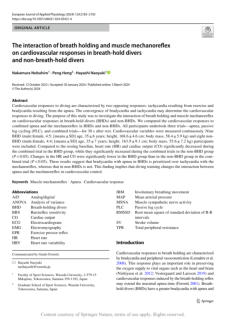

Authors: Steve Sheppard
This Helix presentation provides information about the age
profiles for various positions employed by North Sea
Contractors, acknowledging the potential for data
duplication due to personnel being employed by multiple
contractors. However, its author estimated that this
duplication was less than 4% of the total dataset.


Authors: Costantino Balestra, Clément Lévêque, Simona
Mrakic-Sposta, Alessandra Vezzoli, Pierre Wauthy,
Peter Germonpré, Frauke Tillmans, François
Guerrero, and Pierre Lafère
The Paper presents a study on diving decompression
theory, specifically examining the role of inflammatory
processes in the formation of micronuclei and their
potential risks by testing divers to observe changes in
inflammatory markers and venous gas emboli (VGE) post-
dive. It details the methods, results, and discussion of the
findings, highlighting the relationship between
inflammation and VGE and suggesting that increased
inflammation may lead to the formation of new
micronuclei.


Authors:
Anderson Geremias Macedo, Danilo Alexandre Massini,
Tiago André Freire Almeida, Luciana Maria dos Reis,
Giovane Galdino, Adriana Teresa Silva Santos, Osvaldo
Tadeu da Silva Júnior, Rubens Venditti Júnior, and Dalton
Muller Pessôa Filho
This document presents a systematic review and meta-
analysis that examines the acute and post-exercise
hemodynamic responses to low-load intensity resistance
exercise with blood flow restriction (BFR) compared to
high-load intensity resistance exercise (HI) to determine
whether the cardiovascular responses, specifically heart
rate, blood systolic and diastolic pressure, and rate
pressure product, immediately after and up to 60 minutes
post-exercise, are consistent between the two exercise
protocols in healthy individuals.


Authors:
Maher Khalife, Michele Salvagno, Maurice Sosnowski, and
Costantino Balestra
This study assesses the effectiveness of a normobaric
oxygen paradox (NOP) protocol in stimulating
erythropoiesis in cancer patients undergoing abdominal
surgeries to determine whether NOP can increase
reticulocyte counts, indicating enhanced erythropoiesis in
this patient population. It details the methodology used,
results, and conclusions, highlighting the potential of NOP
therapy while acknowledging the need for further
research.


Authors:
Irina Popova, Evgeniya Dvurekova, Aleksandr Sysoev
This study investigates the body composition and
microcirculation characteristics of qualified divers using
different types of gymnastic equipment to understand
how these factors can improve the effectiveness of
training for divers. It provides specific results regarding
changes in body composition and microcirculatory
function among divers, and highlights the importance of
these findings for enhancing training effectiveness.
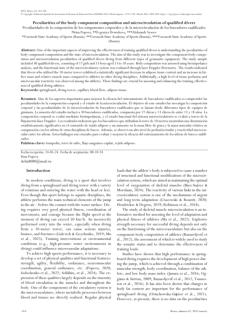

Authors:
Thomas Kjeld, Anders Brenøe Isbrand, Henrik Christian
Arendrup, Jens Højberg, Jacob Bejder, Thomas O. Krag,
John Vissing, Lars Poulsen Tolbod, Johannes Hendrik
Harms, Lars Christian Gormsen, Dan Fuglø, and Egon
Godthaab Hansen
This study investigates the physiological adaptations of
elite breath-hold divers (BHD) during apnea, comparing
them to diving mammals like Bottlenose Dolphins to
explore whether BHD have similar oxygen-conserving
mechanisms, focusing on pulmonary blood volume (PBV)
and alveolar ventilation to perfusion ratio (V A /Q). It
details the methods used, the results obtained, and
highlighs the adaptations of BHD in terms of pulmonary
function and oxygen delivery.


Authors:
Tatjana Baldovin, Francesco Bassan, Chiara Bertoncello,
Alessandra Buja, Silvia Cocchio, Marco Fonzo, and
Vincenzo Baldo
This paper advocates for integrating healthcare simulation
into the training of health professionals, particularly in the
field of Public Health. It highlights the benefits of
simulation in improving clinical performance, reducing
costs, and enhancing education standards. Additionally, it
proposes a pilot project to train professionals using an
interdisciplinary and innovative approach to improve
patient quality and safety further.


Authors:
Irina Evgenievna Popova, Aleksander Vladimirovich
Sysoev, and Viktor Leonidovich Kondakov
This paper conveys research findings on the importance of
neuromuscular development for achieving high
performance in diving. It discusses the correlation
between neuromuscular function and the composition of
muscle and adipose tissue in divers, emphasizing the need
to develop muscle mass and reduce fat to enhance nerve
impulse conductivity and muscle synchronization,
ultimately improving diving performance.


Authors:
Lucille Daubresse, Aurélie Portas, Alexandrine Bertaud,
Marion Marlinge, Sandrine Gaillard, Jean-Jacques Risso,
Céline Ramdani, Jean-Claude Rostain, Nabil Adjiriou,
Anne-Virginie Desruelle, Jean-Eric Blatteau, Régis Guieu,
and Nicolas Vallée
This study investigates the effects of CO2 exposure on the
occurrence of decompression sickness (DCS) in mice to
evaluate whether breathing CO2 prior to a dive increases
the risk of DCS and explores the potential role of body
temperature and microbiota composition in influencing
the outcomes. It details the methodology and results,
highlighting the significant increase in DCS incidence
following CO2 exposure and suggesting a link between
microbiota, thermogenesis, and susceptibility to DCS.
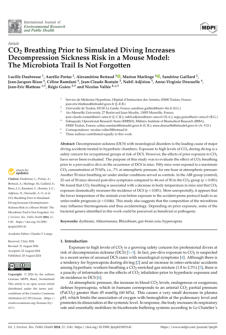

Authors:
T. A. Giacon, Simona Mrakic-Sposta, G. Bosco, A. Vezzoli,
Cinzia Dellanoce, M. Campisi, M. Narici, M. Paganini, B.
Foing, A. Kołodziejczyk, M. Martinelli, S. Pavanello
This study investigates the effects of isolation, circadian
rhythm disruption, and psychophysical stress on humans
in a simulated space environment to understand how
these factors impact stress responses, sleep quality, and
oxidative stress levels in individuals participating in an
analog astronaut mission. The text outlines the methods
used, the results obtained, and the conclusions drawn
from the experiment, highlighting the potential
implications for human performance in space missions.
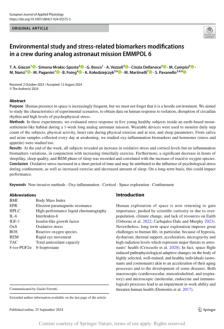

Authors:
Władysław Wolanski, Stanisław Pełka, Józef Ramisc
This document reports on the findings of a pilot program
that incorporated psychological testing into the
recruitment process for military and scuba divers,
highlighting the importance of psychological assessments
in determining the suitability of candidates for diving
training and service, suggesting that such testing should
be a standard part of the selection process, as is done in
other countries.


Authors:
Emmanuel Dugrenot, Anthony Guernec, Jérémy Orsat,
François Guerrero
This study focused on understanding the mechanisms of
decompression sickness (DCS) through genetic and
molecular analysis. It involves selectively bred rats with
increased resistance to DCS and uses analyses to identify
pathways related to inflammatory and immune responses,
as well as other cellular processes. It shares the research
methodology, results, and conclusions, highlighting the
discovery of similar pathways in both male and female
rats, which could contribute to a better understanding of
gene expression and phenotype differences related to
DCS.


Authors:
Emmanuel Gouin, David PM Monnot, Thierry Michot,
François Guerrero, Jean-Eric Blatteau
This small presentation introduces the findings of a study
conducted on the practices and incidents related to deep
diving using helium-mixed-gas, specifically within the
technical diving community, to provide an
epidemiological overview of diving practices, risk factors,
and the occurrence and management of diving-related
incidents.


Authors:
Rhiannon J. Brenner, Kiran A. Balan, Marie P. L. Andersen,
Emmanuel Dugrenot, Xavier C. E. Vrijdag, Hanna Van
Waart & Frauke Tillmans
This paper provides a narrative review of the nutritional
recommendations for recreational scuba divers. It aims to
summarize existing guidelines, highlight the physiological
challenges divers face, and identify research gaps
regarding the relationship between nutritional intake and
the health and safety of divers. In addition, it outlines
specific dietary recommendations based on workload and
diving conditions, emphasizing the importance of
macronutrient distribution and protein intake.
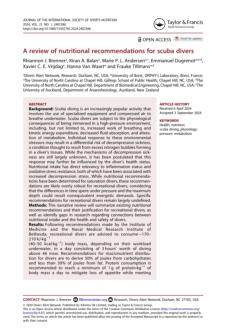

Authors: Muinat Abolore Idris, Christine Markham, Kristina
D. Mena, and William B. Perkison
This presentation describes findings on the factors
affecting heat stress among construction workers,
specifically in the context of natural gas construction sites.
It aims to identify barriers and facilitators to worker safety
and evaluate the effectiveness of a heat stress intervention
program. In addition, it provides recommendations for
improving the safety, health, and well-being of
construction workers in hot environments, emphasizing
the need for employee involvement, employer
management, accessible resources, mandatory rest breaks,
and comprehensive heat stress education.
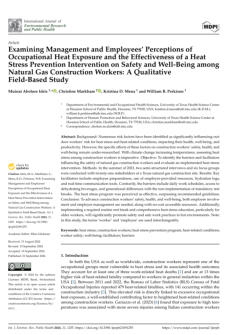

Authors:
Luigi Fattorini, Angelo Rodio, Tommaso Di Libero, Cristian
Ieno, Giovanna Tranfo, Daniela Pigini, Alessandro Pinto,
and Enrico Marchetti
This paper describes the findings of a study on the
physiological effects of SCUBA diving on heart rate (HR) at
different depths that involved recording the HR of 18
healthy subjects while diving in thermal water at a
constant temperature to understand how HR changes
during various phases of a dive and at varying depths,
highlighting the physiological adjustments and cardiac
stress associated with diving.
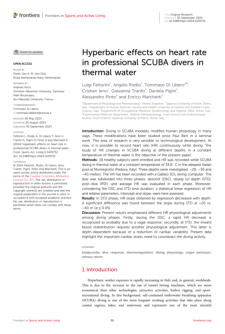

Author: Tom S. Neuman
This document explains the physiological problems
associated with decompression from elevated atmospheric
pressures, mainly focusing on the effects on divers. It
discusses two main categories of issues: mechanical
injuries due to gas expansion and the formation of gas
phases in tissues leading to decompression sickness (DCS).
It also delves into specific conditions, such as pulmonary
overinflation syndromes and arterial gas embolism (AGE),
describing their causes, symptoms, and potential
outcomes.


Authors: Robert A van Hulst, & Pieter-Jan AM van Ooij
This document is a retrospective study on lung function in
military divers, specifically focusing on the incidence of
lung abnormalities such as blebs and bullae and the role
of computed tomography (CT) scans in assessing fitness to
dive. It informs and advises on best practices for evaluating
divers' lung health, suggesting the use of Global Lung
Initiative reference values and recommending high-
resolution CT scans only for those with clinical indications.

Author: Neal W. Pollock
This paper aims to inform and advise divers about the
importance of thermal protection in coldwater diving
environments. It highlights the potential hazards
associated with inadequate and excessive thermal
protection, emphasizing the need for careful consideration
of safety over comfort, discussing the limitations of current
dive computers in assessing thermal status, and
suggesting that divers are responsible for managing their
thermal protection to ensure safety during dives.


Authors:
Hadrien Pique, Sigrid Theunissen, Costantino Balestra,
Juani Valdivia, Oleg Melikho
This study investigates the prevalence of preterm birth
among elite freedivers and its potential impact on their
performance to determine whether being born
prematurely affects freediving results. It concludes that
while the proportion of preterm births is higher among
elite freedivers compared to the general population, there
is no significant difference in performance between
preterm and full-term athletes.


Authors: Jan Risberg, Helle Midtgaard
This paper reports and analyze an unusual incident of
decompression sickness (DCS) that occurred during a
commercial diving project. It details the circumstances of
the incident, including the number of dives, the depth and
duration of the dives, the error in the decompression
procedure, and the resulting cases of DCS. It also discusses
the implications of the error on DCS incidence rates and
provides observations on the effects of omitted
decompression time. Additionally, it includes follow-up
information on the divers involved, noting that some
reported minor symptoms of DCS after the project
concluded.
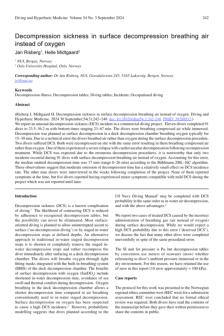

Authors:
Arnaud Druelle, Olivier Castagna, Romain Roffi, Pierre
Louge, Anthony Faivre, and Jean-Eric Blatteau
This paper describes and analyzes an unusual incident of
decompression sickness (DCS) that occurred during a
commercial diving project. It details the circumstances of
the incident, including the number of dives, the depth and
duration of the dives, the error in the decompression
procedure, and the resulting cases of DCS. It also discusses
the implications of the error on DCS incidence rates and
provides observations on the effects of omitted
decompression time. Additionally, it includes follow-up
information on the divers involved, noting that some
reported minor symptoms of DCS after the project
concluded.



This workshop discussed potential updates and revisions
to "The Guide for the Care and Use of Laboratory
Animals". The presentation discusses the efforts made by
the Standing Committee for the Care and Use of Animals
in Research to gather input from various stakeholders
through listening sessions and a survey, culminating in a
virtual workshop. It highlights the collaborative nature of
the workshop, the diversity of participants, and the
collection of feedback and suggestions for future updates
to the Guide.


Authors: Nozomu Kageyama, and Takehito Sawamura
This study investigated the effects of hyperbaric exposure
on cognitive function in divers during saturation diving at
a depth of 45 atmosphere absolute (ATA). The study
utilized Stroop tasks to assess cognitive performance and
found that reaction times were delayed and correct rates
decreased at 45 ATA compared to 1 ATA. The study
emphasizes the importance of monitoring cognitive
function in deep sea saturation diving and suggests the
need for further research and training in this area.


Authors: Andreas Fahlman, Warren Burggren, and
William K. Milsom
The aim of this document is to present research findings
and insights on the dive response in air-breathing
vertebrates, particularly focusing on the role of cognitive
control and conditioning in heart rate regulation during
dives to explain how these physiological responses can be
anticipatory and vary based on the type and length of the
dive, suggesting a cognitive component. It also discusses
the implications of these findings for improving diving
capacity and preventing diving-related issues, such as
decompression sickness, through mechanisms like the
selective gas exchange hypothesis..


Authors: Emmanuel Dugrenot, Anthony Guernec, Jérémy
Orsat, & François Guerrero
This paper presents a study on the effects of hyperbaric
conditions on cognitive functioning, explicitly using the
critical flicker fusion frequency (CFFF) test. It highlights the
importance of considering possible side effects of
hyperbaric oxygen therapy (HBOT) on medical staff, such
as decompression sickness, and reports findings on how
oxygen breathing during decompression affects CFFF
results.


Authors: Rita I. Sharma, Natalia D. Mankowska, Anna B.
Marcinkowska, Pawel J. Winklewski, Jacek Kot
This paper presents a study on the effects of hyperbaric
conditions on cognitive functioning, explicitly using the
critical flicker fusion frequency (CFFF) test. It highlights the
importance of considering possible side effects of
hyperbaric oxygen therapy (HBOT) on medical staff, such
as decompression sickness, and reports findings on how
oxygen breathing during decompression affects CFFF
results.


This document is the 2024 update of the Declaration of
Helsinki, developed by the World Medical Association
(WMA), for conducting safe and respectful medical
research involving human participants. It aims to
communicate the principles of the organization that
should be adhered to by all parties involved in medical
research to ensure the protection of research participants.
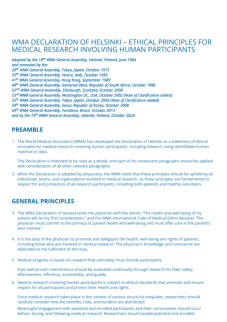

Authors:
Zuha Imtiyaz, Owen J. O'Neill, Douglas Sward, Phi- Nga
Jeannie Le, Awadhesh K. Arya, Veena M. Bhopale, Abid R.
Bhat, Stephen R. Thom
This text presents a scientific hypothesis and research
findings regarding the physiological responses of tunnel
construction workers to high-pressure exposures
compared to SCUBA divers. The study aims to investigate
the inflammatory responses and potential
pathophysiology of decompression sickness (DCS) in these
two groups, focusing on blood microparticles, interleukin
levels, plasma gelsolin, and neutrophil activation. The text
concludes with findings that suggest differences in
neutrophil activation based on the duration of pressure
exposure












